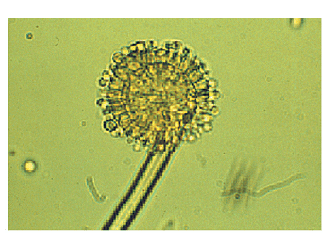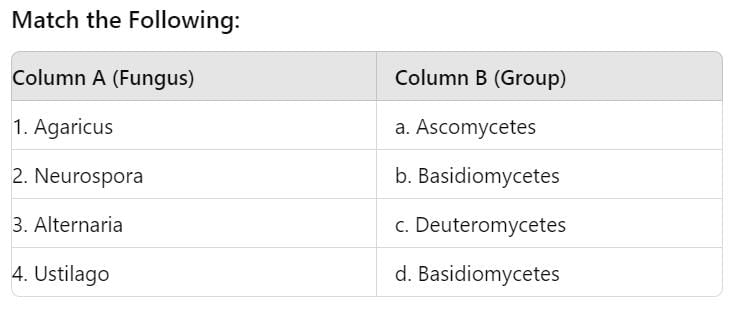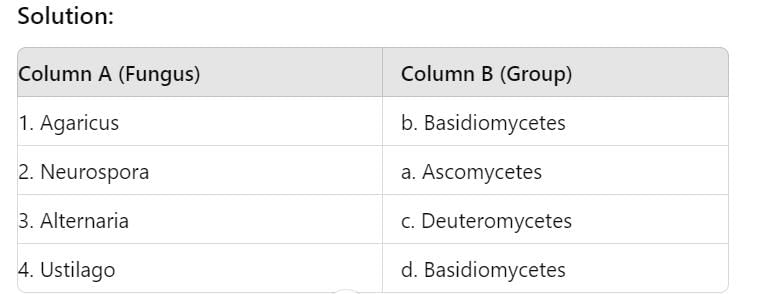All questions of Introduction to Fungi for Grade 9 Exam
Asexual spores in Ascomycetes are called as _______- a)Ascospores
- b)Conidia
- c)Sporangiospores
- d)Aeciospores
Correct answer is option 'B'. Can you explain this answer?
Asexual spores in Ascomycetes are called as _______
a)
Ascospores
b)
Conidia
c)
Sporangiospores
d)
Aeciospores
|
|
Jaspreet answered |
Conidia is a sexual spores in ascomycetes which are produced exogenously on conidiophores :)
Coenocytic means _______- a)sharing of common cytoplasm
- b)removal of plasma membrane
- c)sharing of common nucleus
- d)sharing of common hyphael wall
Correct answer is option 'A'. Can you explain this answer?
Coenocytic means _______
a)
sharing of common cytoplasm
b)
removal of plasma membrane
c)
sharing of common nucleus
d)
sharing of common hyphael wall
|
|
Srestha Bose answered |
Coenocytic means sharing of common cytoplasm. This term is commonly used to describe a type of cell or organism that does not have distinct cell boundaries or compartments. Instead, coenocytic cells contain multiple nuclei within a single, continuous cytoplasmic mass.
Explanation:
Coenocytic cells are typically found in fungi, algae, and some types of plants. In these organisms, individual cells may fuse together during development to form a single, multinucleate cell. This single cell may then develop into a larger structure or organism, such as a fungus or alga.
Some key characteristics of coenocytic cells include:
- Lack of cell walls: Coenocytic cells do not have distinct cell walls separating them from neighboring cells. Instead, they are connected by a network of cytoplasmic strands.
- Multiple nuclei: Because coenocytic cells contain multiple nuclei within a single cytoplasmic mass, they are often referred to as multinucleate.
- Large size: Without the constraints of cell walls, coenocytic cells can grow to very large sizes. Some fungi, for example, can form structures that are many meters in length.
Overall, the term "coenocytic" refers to a unique type of cell organization that is characterized by the sharing of cytoplasmic material between multiple nuclei.
Explanation:
Coenocytic cells are typically found in fungi, algae, and some types of plants. In these organisms, individual cells may fuse together during development to form a single, multinucleate cell. This single cell may then develop into a larger structure or organism, such as a fungus or alga.
Some key characteristics of coenocytic cells include:
- Lack of cell walls: Coenocytic cells do not have distinct cell walls separating them from neighboring cells. Instead, they are connected by a network of cytoplasmic strands.
- Multiple nuclei: Because coenocytic cells contain multiple nuclei within a single cytoplasmic mass, they are often referred to as multinucleate.
- Large size: Without the constraints of cell walls, coenocytic cells can grow to very large sizes. Some fungi, for example, can form structures that are many meters in length.
Overall, the term "coenocytic" refers to a unique type of cell organization that is characterized by the sharing of cytoplasmic material between multiple nuclei.
Rhizopus belongs to _________- a)Phycomycetes
- b)Ascomycetes
- c)Basidiomycetes
- d)Deuteromycetes
Correct answer is option 'A'. Can you explain this answer?
Rhizopus belongs to _________
a)
Phycomycetes
b)
Ascomycetes
c)
Basidiomycetes
d)
Deuteromycetes
|
|
Jaspreet answered |
Rhizopus belongs to Phycomycetes :)
Non-motile spores in Phycomycetes are called as _____- a)Phycospores
- b)Zoospores
- c)Aplanospores
- d)Zygospores
Correct answer is option 'C'. Can you explain this answer?
Non-motile spores in Phycomycetes are called as _____
a)
Phycospores
b)
Zoospores
c)
Aplanospores
d)
Zygospores

|
Prahlad Pai answered |
Non motile spore in phycomycetes is aplanospores
Which among the following are incorrect about Phycomycetes?- a)Phycomycetes are aseptate fungi and are coenocytic
- b)Phycomycetes are also called as algal fungi
- c)Zygospores are formed due to isogamous fertilization and zoospores are formed due to anisogamous fertilization
- d)Phycomycetes are also called as conjugation fungi
Correct answer is option 'C'. Can you explain this answer?
Which among the following are incorrect about Phycomycetes?
a)
Phycomycetes are aseptate fungi and are coenocytic
b)
Phycomycetes are also called as algal fungi
c)
Zygospores are formed due to isogamous fertilization and zoospores are formed due to anisogamous fertilization
d)
Phycomycetes are also called as conjugation fungi
|
|
Geetika Shah answered |
Zygospores are formed either due to isogamous or anisogamous fertilization. Zoospores and aplanospores are motile and non-motile spores produced due to asexual mode respectively. Phycomycetes are aseptate fungi and are coenocytic. Phycomycetes are also called as algal fungi or conjugation fungi.
In fungi, asexual reproduction takes place by- a) Fission, conidia and ascospores
- b)Conidia, hypnospores and zoospores
- c)Conidia, sporangiospores and zoospores
- d)Sporangiospores, conidia and basidiospores
Correct answer is option 'C'. Can you explain this answer?
In fungi, asexual reproduction takes place by
a)
Fission, conidia and ascospores
b)
Conidia, hypnospores and zoospores
c)
Conidia, sporangiospores and zoospores
d)
Sporangiospores, conidia and basidiospores

|
EduRev NEET answered |
Asexual reproduction is by spores called conidia or sporangiospores or zoospores, and sexual reproduction is by oospores, ascospores and basidiospores
Identify the group of fungi that is not correctly matched with all the characters given below:- a)Phycomycetes: Mycelium – aseptate and coenocytic / Asexual reproduction by motile zoospores or by nonmotile aplanospores / spores – endogenously produced in the sporangium
- b)Ascomycetes: Mycelium – unbranched and septate / Asexual spores are conidia / Conidia produced endogenously on conidiophores.
- c)Basidiomycetes: Mycelium–branched and septate / Asexual spores are generally not found.
- d)Deuteromycetes: Only the asexual or vegetative phase of these fungi are known.
Correct answer is option 'B'. Can you explain this answer?
Identify the group of fungi that is not correctly matched with all the characters given below:
a)
Phycomycetes: Mycelium – aseptate and coenocytic / Asexual reproduction by motile zoospores or by nonmotile aplanospores / spores – endogenously produced in the sporangium
b)
Ascomycetes: Mycelium – unbranched and septate / Asexual spores are conidia / Conidia produced endogenously on conidiophores.
c)
Basidiomycetes: Mycelium–branched and septate / Asexual spores are generally not found.
d)
Deuteromycetes: Only the asexual or vegetative phase of these fungi are known.

|
EduRev NEET answered |
Commonly known as sac-fungi, the ascomycetes are mostly multicellular, e.g., Penicillium, or rarelyunicellular, e.g., yeast (Saccharomyces). They are saprophytic, decomposers, parasitic or coprophilous (growing on dung). is branched and septate. The asexual spores are conidia produced exogenously on the special mycelium called conidiophores
Where are members of phycomycetes primarily found?- a)In dry desert regions
- b)In high-altitude mountain areas
- c)In aquatic habitats and on decaying wood in moist places
- d)In arid deserts and sandy soils
Correct answer is option 'C'. Can you explain this answer?
Where are members of phycomycetes primarily found?
a)
In dry desert regions
b)
In high-altitude mountain areas
c)
In aquatic habitats and on decaying wood in moist places
d)
In arid deserts and sandy soils

|
Ambition Institute answered |
Members of phycomycetes are found in aquatic habitats and on decaying wood in moist and damp places or as obligate parasites on plants.
What are the three main steps involved in the sexual cycle in sequence?- a)Karyoogamy→ Plasmogamy→ Meiosis
- b)Plasmogamy→ Meiosis → Karyogamy
- c)Plasmogamy→ Karyogamy → Meiosis
- d)None of these
Correct answer is option 'C'. Can you explain this answer?
What are the three main steps involved in the sexual cycle in sequence?
a)
Karyoogamy→ Plasmogamy→ Meiosis
b)
Plasmogamy→ Meiosis → Karyogamy
c)
Plasmogamy→ Karyogamy → Meiosis
d)
None of these

|
Bs Academy answered |
The sexual cycle involves the following three steps: (i) Fusion of protoplasms between two motile or non-motile gametes called plasmogamy. (ii) Fusion of two nuclei called karyogamy. (iii) Meiosis in zygote resulting in haploid spores
Assertion(A): Deuteromycetes are called imperfect fungi.
Reason(R): These fungi have autotrophic mode of nutrition .- a)Both (A) and (R) are true and (R) is the correct explanation of (A).
- b)Both (A) and (R) are true, but (R) is not the correct explanation of (A).
- c) (A) is true, but (R) is false.
- d)(A) is false, but (R) is true.
Correct answer is option 'C'. Can you explain this answer?
Assertion(A): Deuteromycetes are called imperfect fungi.
Reason(R): These fungi have autotrophic mode of nutrition .
Reason(R): These fungi have autotrophic mode of nutrition .
a)
Both (A) and (R) are true and (R) is the correct explanation of (A).
b)
Both (A) and (R) are true, but (R) is not the correct explanation of (A).
c)
(A) is true, but (R) is false.
d)
(A) is false, but (R) is true.

|
Bs Academy answered |
- Deuteromycetes are indeed called "imperfect fungi" because only the asexual or vegetative phases of these fungi are known. When the sexual forms of these fungi were discovered they were moved into classes they rightly belong to. It is also possible that the asexual and vegetative stage have been given one name (and placed under deuteromycetes) and the sexual stage another (and placed under another class)
- However, the reason given in the statement that these fungi have an autotrophic mode of nutrition is incorrect. Deuteromycetes are actually heterotrophic, not autotrophic.
- Therefore, the correct answer is: C: (A) is true, but (R) is false.
- However, the reason given in the statement that these fungi have an autotrophic mode of nutrition is incorrect. Deuteromycetes are actually heterotrophic, not autotrophic.
- Therefore, the correct answer is: C: (A) is true, but (R) is false.
Lichens are __________- a)symbiotic existence of blue-green algae and fungi
- b)symbiotic existence of rhizobium bacteria in the roots of leguminous plants
- c)co-existence of coral reef with zooxanthellae
- d)existence of mycorrhiza along with leguminous plants
Correct answer is option 'C'. Can you explain this answer?
Lichens are __________
a)
symbiotic existence of blue-green algae and fungi
b)
symbiotic existence of rhizobium bacteria in the roots of leguminous plants
c)
co-existence of coral reef with zooxanthellae
d)
existence of mycorrhiza along with leguminous plants
|
|
Muhammed Anzal! answered |
No the Correct answer is A. Algal component is called Phycobiont and fungal component is called Mycobiont
A ‘dikaryon’ stage is seen in the members of:- a). Ascomycetes and Phycomycetes
- b)Ascomycetes and Basidiomycetes
- c)Basidiomycetes and Phycomycetes
- d)Basidiomycetes and Deuteromycetes
Correct answer is option 'B'. Can you explain this answer?
A ‘dikaryon’ stage is seen in the members of:
a)
. Ascomycetes and Phycomycetes
b)
Ascomycetes and Basidiomycetes
c)
Basidiomycetes and Phycomycetes
d)
Basidiomycetes and Deuteromycetes

|
EduRev NEET answered |
When a fungus reproduces sexually, two haploid hyphae of compatible mating types come together and fuse. In some fungi the fusion of two haploid cells immediately results in diploid cells (2n). However, in other fungi (ascomycetes and basidiomycetes), an intervening dikaryotic stage (n + n, i.e., two nuclei per cell) occurs; such a condition is called a dikaryon and the phase is called dikaryophase of fungus
Identify the incorrect statement about the diagram of the fungi given below -
- a)The asexual spores are conidia produced exogenously on the special mycelium called conidiophores
- b)Sexual spores are called ascospores
- c)Fruiting bodies are called ascocarps.
- d)Fruiting bodies called ascospores.
Correct answer is option 'D'. Can you explain this answer?
Identify the incorrect statement about the diagram of the fungi given below -

a)
The asexual spores are conidia produced exogenously on the special mycelium called conidiophores
b)
Sexual spores are called ascospores
c)
Fruiting bodies are called ascocarps.
d)
Fruiting bodies called ascospores.

|
Bs Academy answered |
Figure mentioned in the question is aspergillus which belong to class ascomycetes.
The asexual spores are conidia produced exogenously on the special mycelium called conidiophores. Conidia on germination produce mycelium. Sexual spores are called ascospores which are produced endogenously in sac like asci (singular ascus). These asci are arranged in different types of fruiting bodies called ascocarps. Some examples are Aspergillus, Claviceps and Neurospora.
What is the term for the long, slender thread-like structures that make up the body of fungi?- a)Spores
- b)Hyphae
- c)Mycorrhizae
- d)Stolons
Correct answer is option 'B'. Can you explain this answer?
What is the term for the long, slender thread-like structures that make up the body of fungi?
a)
Spores
b)
Hyphae
c)
Mycorrhizae
d)
Stolons

|
Infinity Academy answered |
fungi are filamentous. Their bodies consist of long, slender thread-like structures called hyphae. The network of hyphae is known as mycelium. Some hyphae are continuous tubes filled with multinucleated cytoplasm – these are called coenocytic hyphae. Others have septae or cross walls in their hyphae. The cell walls of fungi are composed of chitin and polysaccharides.
Which of the following is not true regarding the reproduction and life cycle of basidiomycetes?- a)Basidiomycetes reproduce asexually through the formation of basidiospores.
- b)The sex organs are absent in basidiomycetes.
- c)Plasmogamy is brought about by the fusion of two vegetative or somatic cells.
- d)Basidia are arranged in fruiting bodies called basidiocarps.
Correct answer is option 'A'. Can you explain this answer?
Which of the following is not true regarding the reproduction and life cycle of basidiomycetes?
a)
Basidiomycetes reproduce asexually through the formation of basidiospores.
b)
The sex organs are absent in basidiomycetes.
c)
Plasmogamy is brought about by the fusion of two vegetative or somatic cells.
d)
Basidia are arranged in fruiting bodies called basidiocarps.

|
EduRev NEET answered |
a) Basidiomycetes reproduce asexually through the formation of basidiospores.
This statement is not true because basidiomycetes primarily reproduce sexually through the formation of basidiospores, which are produced on basidia after plasmogamy and karyogamy. Asexual reproduction is not the primary mode of reproduction in basidiomycetes, though some may produce conidia or other forms of asexual spores in certain circumstances.
The other statements are true:
- b) The sex organs are absent in basidiomycetes. This is true because basidiomycetes do not have distinct male and female sex organs. Sexual reproduction occurs through the fusion of specialized sexual cells.
- c) Plasmogamy is brought about by the fusion of two vegetative or somatic cells. This is true. Plasmogamy involves the fusion of two somatic cells, leading to the formation of a dikaryotic mycelium in basidiomycetes.
- d) Basidia are arranged in fruiting bodies called basidiocarps. This is true. Basidia, which produce basidiospores, are typically found in fruiting bodies known as basidiocarps.
Topic in NCERT: Fungal Reproduction
Line in NCERT: "The sex organs are absent, but plasmogamy is brought about by fusion of two vegetative or somatic cells of different strains or genotypes."
Chapter doubts & questions for Introduction to Fungi - Biology 2025 is part of Grade 9 exam preparation. The chapters have been prepared according to the Grade 9 exam syllabus. The Chapter doubts & questions, notes, tests & MCQs are made for Grade 9 2025 Exam. Find important definitions, questions, notes, meanings, examples, exercises, MCQs and online tests here.
Chapter doubts & questions of Introduction to Fungi - Biology in English & Hindi are available as part of Grade 9 exam.
Download more important topics, notes, lectures and mock test series for Grade 9 Exam by signing up for free.
Biology
153 videos|283 docs|127 tests
|

Contact Support
Our team is online on weekdays between 10 AM - 7 PM
Typical reply within 3 hours
|
Free Exam Preparation
at your Fingertips!
Access Free Study Material - Test Series, Structured Courses, Free Videos & Study Notes and Prepare for Your Exam With Ease

 Join the 10M+ students on EduRev
Join the 10M+ students on EduRev
|

|
Create your account for free
OR
Forgot Password
OR
Signup to see your scores
go up within 7 days!
Access 1000+ FREE Docs, Videos and Tests
Takes less than 10 seconds to signup











